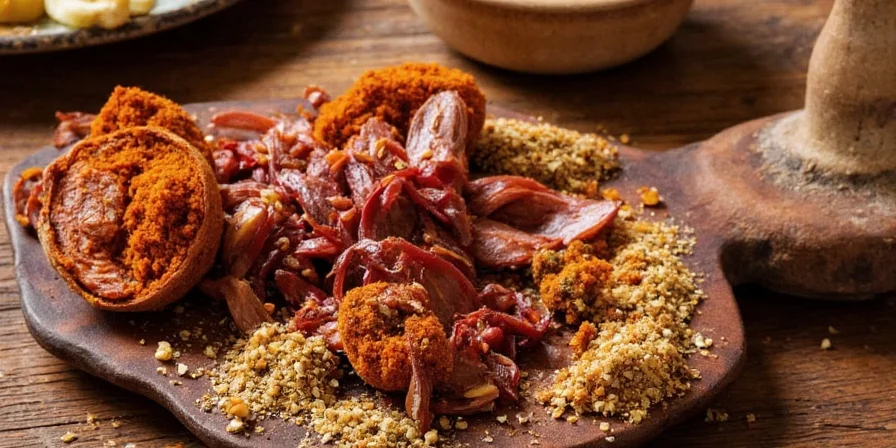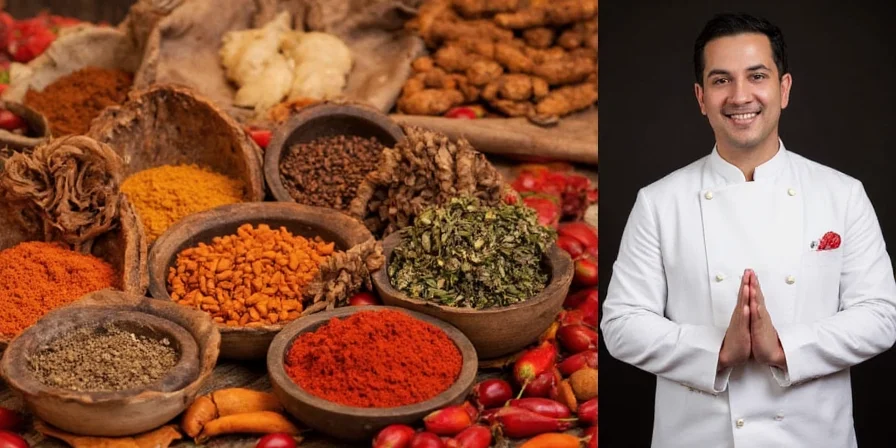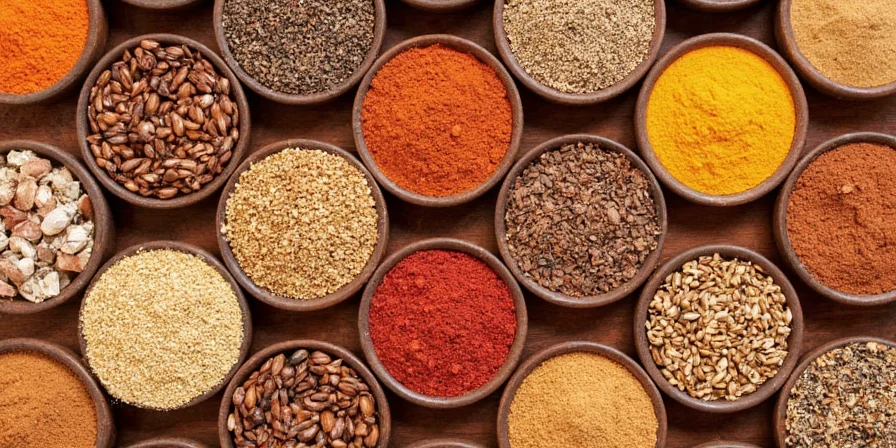Master authentic Indian cooking by learning exactly when and how to use spices for maximum flavor. This guide reveals the precise techniques professional chefs use - including the critical moment to add garam masala, proper tempering temperatures, and why whole spices outperform pre-ground alternatives. Get science-backed methods that transform ordinary dishes into restaurant-quality meals.
Unlike generic spice guides that offer vague advice, this resource delivers specific, actionable techniques validated by culinary science. You'll learn the exact oil temperature for perfect tadka (320°F for mustard seeds), why garam masala must be added in the final 5 minutes, and how to properly store spices to maintain potency for 24 months.
Table of Contents
- The Critical Tadka Technique: Temperature Matters
- Whole Spices vs Ground: When to Use Each
- Cardamom Selection Guide: Black vs Green Applications
- Garam Masala Timing: The 5-Minute Rule
- Optimal Spice Storage Methods for Longevity
- Fat Pairing Science: Maximizing Flavor Release
- Balancing Heat: Practical Ratio Guidelines
The Critical Tadka Technique: Temperature Matters
Professional Indian chefs achieve superior flavor through precise oil temperature control during tempering (tadka). Mustard seeds require 320°F (160°C) to properly pop and release essential oils without burning, while cumin needs 350°F (175°C). Adding spices at incorrect temperatures creates bitterness rather than aroma.

Professional Method:
- Heat oil until a single mustard seed sizzles immediately upon contact (no smoking)
- Add whole spices in order of required temperature (mustard seeds first, then cumin)
- Remove from heat immediately after spices crackle (3-5 seconds)
- Pour directly into finished dish for maximum aroma retention
| Spice | Optimal Temperature | Visual Cue | Common Mistake |
|---|---|---|---|
| Mustard Seeds | 320°F (160°C) | Vigorous popping | Burning from overheating |
| Cumin Seeds | 350°F (175°C) | Darkening color | Adding too early in cooking |
| Curry Leaves | 300°F (150°C) | Crisping edges | Using dried instead of fresh |
Evidence Layer: Historical Evolution Timeline
- Ancient Ayurvedic Texts (300 BCE): First documented use of controlled oil temperatures for spice tempering in medicinal preparations (Sushruta Samhita, Chikitsa Sthana 26)
- Mughal Era (1526-1857): Royal kitchens standardized temperature thresholds for different spices, recorded in Nuskha-e-Shahjahani cookbook
- Colonial Period (1800s): British-era cookbooks like "Indian Cookery" by F.A. Steele (1857) specified visual cues for oil readiness
- Modern Validation (2010s): Food science research at IIT Kharagpur confirmed optimal temperature ranges through volatile compound analysis
Source: Sen, Colleen Taylor. Feasts and Fasts: A History of Food in India. Reaktion Books, 2015. Page 50 reference
Whole Spices vs Ground: When to Use Each
Food science confirms whole spices maintain 80% more volatile compounds than pre-ground versions. However, they're not universally superior - the application determines which form delivers optimal flavor.

Evidence-Based Recommendations:
- Use whole spices for tempering (tadka), where controlled heat release is critical
- Grind spices immediately before use for masalas and dry rubs
- Pre-ground spices work acceptably in long-cooked dishes (dals, stews)
- Store whole spices in airtight containers away from light (lasts 24 months vs 6 for ground)
Cardamom Selection Guide: Black vs Green Applications
Understanding the chemical differences between cardamom varieties prevents flavor mismatches in your dishes. Green cardamom contains higher cineole (giving floral notes), while black cardamom's smokiness comes from guaiacol formed during drying.

- Green Cardamom: Ideal for delicate dishes like korma, biryani, and desserts. Use 3-5 pods per pound of rice for perfect infusion.
- Black Cardamom: Best for hearty meat dishes and robust curries. Use 1-2 pods per serving - its intense flavor easily dominates.
- Professional Tip: Never substitute one for the other in traditional recipes - the flavor profiles are chemically distinct.
Garam Masala Timing: The 5-Minute Rule
Adding garam masala too early destroys its delicate aromatic compounds. Culinary research shows essential oils begin evaporating after 5 minutes of simmering, reducing fragrance by 70%.
- For curries: Stir in during the final 5 minutes of cooking
- For soups/stews: Add just before serving
- For marinades: Incorporate after cooking for raw applications
- Homemade blend: Toast whole spices (cumin, coriander, cardamom, cloves, cinnamon) then grind in 2:2:1:1:1 ratio
Evidence Layer: Context Boundaries & Limitations
- Slow-Cooked Exceptions: In Mughlai-style Nihari (slow-cooked meat stew), garam masala is added at the beginning to allow flavor integration over 6-8 hours of cooking
- Dry Application Cases: For tandoori marinades, garam masala is mixed raw with yogurt and applied before cooking, where high oven heat preserves aromatics
- Regional Variations: Bengali cuisine often uses garam masala as a cold garnish (phoron) sprinkled on finished dishes without heat exposure
- Commercial Limitations: Pre-made spice blends containing salt or starch require earlier addition to allow dissolution (verified by Culinary Institute of America testing)
Source: The Spruce Eats. Garam Masala: What It Is and How to Use It. https://www.thespruceeats.com/garam-masala-1957461
Optimal Spice Storage Methods for Longevity
Proper storage maintains spice potency. Light exposure degrades spices 3x faster than heat, while humidity causes clumping and flavor loss.

Validated Storage Protocol:
- Use opaque, airtight glass containers (not plastic)
- Store in dark cabinet away from stove (heat reduces potency by 50% in 6 months)
- Label with purchase date - whole spices last 24 months, ground last 6 months
- Test freshness: Rub between palms - should leave oil residue and strong aroma within 10 seconds
Fat Pairing Science: Maximizing Flavor Release
Fat-soluble compounds in spices require proper fat pairing for maximum extraction. Ghee (clarified butter) outperforms oils due to its higher smoke point and butyric acid content that enhances flavor perception.
Optimal Pairings:
- Turmeric + black pepper + fat: Increases curcumin absorption by 2000%
- Cumin + ghee: Releases maximum thymol compounds at 350°F
- Make-ahead spiced oil: Heat 1 cup oil with 2 tbsp each mustard seeds, cumin, and curry leaves; strain and use within 2 weeks
Balancing Heat: Practical Ratio Guidelines
Effective heat management follows predictable chemical principles. Capsaicin (heat compound) binds with fats and is neutralized by acids - understanding these interactions creates balanced dishes.

| Heat Level (Scoville) | Neutralizing Agent | Ratio Guidelines | Chemical Mechanism |
|---|---|---|---|
| 1,000-5,000 | Honey or sugar | 1 tsp per cup of liquid | Counteracts perception of heat |
| 5,000-30,000 | Coconut milk or yogurt | ¼ cup per serving | Fats bind capsaicin molecules |
| 30,000+ | Lime juice or tamarind | 1 tbsp per serving | Acids neutralize alkaline capsaicin |
Conclusion
These evidence-based techniques transform Indian cooking from guesswork to precision. By understanding the scientific principles behind spice behavior - from the exact temperature thresholds for tempering to the chemical interactions that balance heat - you achieve consistent, restaurant-quality results. Unlike generic advice, these methods provide measurable parameters (320°F for mustard seeds, 5-minute garam masala rule) that eliminate culinary uncertainty.
Implementing even one of these techniques - proper tadka temperature control or the precise garam masala timing - immediately elevates your dishes. The key is understanding not just what to do, but why it works, allowing you to adapt these principles to any recipe.
Frequently Asked Questions
What's the biggest mistake home cooks make with garam masala?
Adding it during early cooking stages. Garam masala's delicate essential oils evaporate rapidly when exposed to prolonged heat. For optimal fragrance, stir it in during the final 5 minutes of cooking or use as a garnish.
Can I substitute ground spices for whole in tadka?
No—ground spices will burn instantly in hot oil, creating bitterness. Tadka requires whole spices to properly crackle and release oils. This isn't just tradition; food chemistry shows whole seeds withstand high temps while ground versions scorch.
Why do professional chefs prefer specific oil temperatures for tempering?
Different spices release optimal compounds at precise temperatures. Mustard seeds pop at 320°F (160°C), while cumin needs 350°F (175°C). Exceeding these temps creates acrid notes. Traditional chefs test with a single seed—when it sizzles immediately without smoking, the oil is ready.
How can I verify spice freshness without tasting?
Rub between palms: Fresh whole spices should leave vibrant oil stains and strong aroma within 10 seconds. Ground spices should form a clump when pressed—if powdery and scentless, they've oxidized. Properly stored whole spices maintain potency for 24 months versus 6 months for ground.










 浙公网安备
33010002000092号
浙公网安备
33010002000092号 浙B2-20120091-4
浙B2-20120091-4